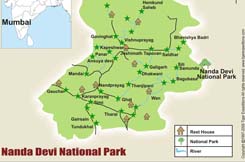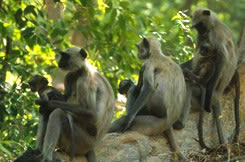Situated in the vicinity of the Nanda Devi Peak at the height of 25765 ft. the second highest peak in India, the Nanda Devi National Park has some of the most unique high altitude flora and fauna in the world. Declared as a World Heritage Site by UNESCO, it is in the vicinity of the Valley of Flowers . A Biosphere Reserve, the Nanda Devi National Park covers an area of 630 Sq.km. For six months of the year the regions remains snow covered. For rest of the months the regions remains dry and rain fall takes place in months of June to August.
The Nanda Devi Peak is considered to be one of the toughest peaks to climb in the world and a favorite destination of mountaineers from across the globe.
The Vegetation : In total, 312 flora species have been found here of which around 17 are considered rare. The main vegetation here is of fir, birch, rhododendron, and juniper. In the inner sanctuary, conditions are drier and near the Nanda Devi Glacier, the vegetation is almost nil. Starting from Ramani, the vegetation changes to alpine and the place is dominated by the juniper scrubs, which gradually leads to the area with grasses, prone mosses, and lichens.
Mammals : Animal population of species like bharal, Himalayan tahr, serow, goral, snow leopard, Himalayan black bear, brown bear, leopard, common langur, Himalayan musk deer, and brown beer dominate the park area.
Birds : There are nearly 80 species of birds in this area. Warblers, gresbreaks, rose finches and ruby throat are commonly seen here. |

